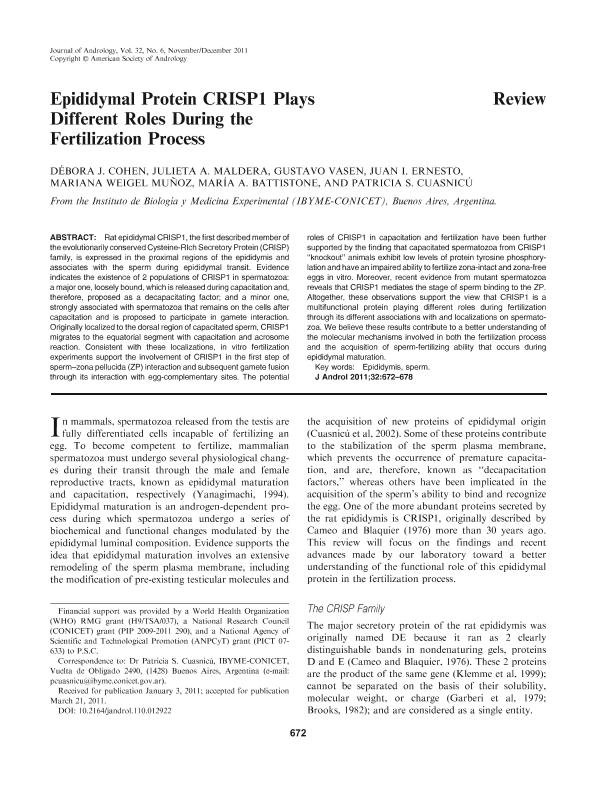Artículo
Epididymal protein CRISP1 plays different roles during the fertilization process
Cohen, Debora Juana ; Maldera, Julieta Antonella
; Maldera, Julieta Antonella ; Vasen, Gustavo
; Vasen, Gustavo ; Ernesto, Juan Ignacio
; Ernesto, Juan Ignacio ; Weigel Muñoz, Mariana
; Weigel Muñoz, Mariana ; Battistone, Maria Agustina
; Battistone, Maria Agustina ; Cuasnicu, Patricia Sara
; Cuasnicu, Patricia Sara
 ; Maldera, Julieta Antonella
; Maldera, Julieta Antonella ; Vasen, Gustavo
; Vasen, Gustavo ; Ernesto, Juan Ignacio
; Ernesto, Juan Ignacio ; Weigel Muñoz, Mariana
; Weigel Muñoz, Mariana ; Battistone, Maria Agustina
; Battistone, Maria Agustina ; Cuasnicu, Patricia Sara
; Cuasnicu, Patricia Sara
Fecha de publicación:
11/2011
Editorial:
American Society of Andrology
Revista:
Journal of Andrology
ISSN:
0196-3635
e-ISSN:
1939-4640
Idioma:
Inglés
Tipo de recurso:
Artículo publicado
Clasificación temática:
Resumen
Rat epididymal CRISP1, the first described member of the evolutionarily conserved Cysteine-RIch Secretory Protein (CRISP) family, is expressed in the proximal regions of the epididymis and associates with the sperm during epididymal transit. Evidence indicates the existence of 2 populations of CRISP1 in spermatozoa: a major one, loosely bound, which is released during capacitation and, therefore, proposed as a decapacitating factor; and a minor one, strongly associated with spermatozoa that remains on the cells after capacitation and is proposed to participate in gamete interaction. Originally localized to the dorsal region of capacitated sperm, CRISP1 migrates to the equatorial segment with capacitation and acrosome reaction. Consistent with these localizations, in vitro fertilization experiments support the involvement of CRISP1 in the first step of sperm-zona pellucida (ZP) interaction and subsequent gamete fusion through its interaction with egg-complementary sites. The potential roles of CRISP1 in capacitation and fertilization have been further supported by the finding that capacitated spermatozoa from CRISP1 "knockout" animals exhibit low levels of protein tyrosine phosphorylation and have an impaired ability to fertilize zona-intact and zona-free eggs in vitro. Moreover, recent evidence from mutant spermatozoa reveals that CRISP1 mediates the stage of sperm binding to the ZP. Altogether, these observations support the view that CRISP1 is a multifunctional protein playing different roles during fertilization through its different associations with and localizations on spermatozoa. We believe these results contribute to a better understanding of the molecular mechanisms involved in both the fertilization process and the acquisition of sperm-fertilizing ability that occurs during epididymal maturation.
Palabras clave:
Sperm
,
Epididymis
,
Membrane Glycoproteins
,
Fertilization
,
Interactin Sperm Ovum
Archivos asociados
Licencia
Identificadores
Colecciones
Articulos(IBYME)
Articulos de INST.DE BIOLOGIA Y MEDICINA EXPERIMENTAL (I)
Articulos de INST.DE BIOLOGIA Y MEDICINA EXPERIMENTAL (I)
Citación
Cohen, Debora Juana; Maldera, Julieta Antonella; Vasen, Gustavo; Ernesto, Juan Ignacio; Weigel Muñoz, Mariana; et al.; Epididymal protein CRISP1 plays different roles during the fertilization process; American Society of Andrology; Journal of Andrology; 32; 6; 11-2011; 672-678
Compartir
Altmétricas



